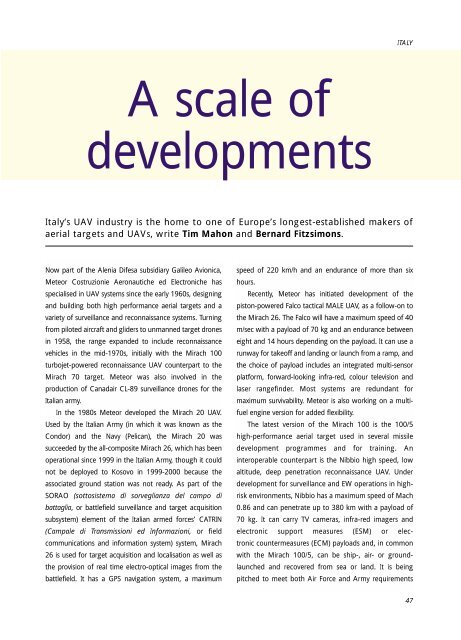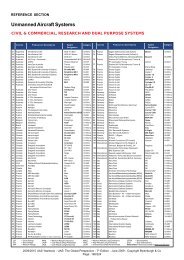Preview - UVS Info
Preview - UVS Info
Preview - UVS Info
You also want an ePaper? Increase the reach of your titles
YUMPU automatically turns print PDFs into web optimized ePapers that Google loves.
A scale of<br />
developments<br />
Italy’s UAV industry is the home to one of Europe’s longest-established makers of<br />
aerial targets and UAVs, write Tim Mahon and Bernard Fitzsimons.<br />
Now part of the Alenia Difesa subsidiary Galileo Avionica,<br />
Meteor Costruzionie Aeronautiche ed Electroniche has<br />
specialised in UAV systems since the early 1960s, designing<br />
and building both high performance aerial targets and a<br />
variety of surveillance and reconnaissance systems. Turning<br />
from piloted aircraft and gliders to unmanned target drones<br />
in 1958, the range expanded to include reconnaissance<br />
vehicles in the mid-1970s, initially with the Mirach 100<br />
turbojet-powered reconnaissance UAV counterpart to the<br />
Mirach 70 target. Meteor was also involved in the<br />
production of Canadair CL-89 surveillance drones for the<br />
Italian army.<br />
In the 1980s Meteor developed the Mirach 20 UAV.<br />
Used by the Italian Army (in which it was known as the<br />
Condor) and the Navy (Pelican), the Mirach 20 was<br />
succeeded by the all-composite Mirach 26, which has been<br />
operational since 1999 in the Italian Army, though it could<br />
not be deployed to Kosovo in 1999-2000 because the<br />
associated ground station was not ready. As part of the<br />
SORAO (sottosistema di sorveglianza del campo di<br />
battaglia, or battlefield surveillance and target acquisition<br />
subsystem) element of the Italian armed forces’ CATRIN<br />
(Campale di Transmissioni ed <strong>Info</strong>rmazioni, or field<br />
communications and information system) system, Mirach<br />
26 is used for target acquisition and localisation as well as<br />
the provision of real time electro-optical images from the<br />
battlefield. It has a GPS navigation system, a maximum<br />
ITALY<br />
speed of 220 km/h and an endurance of more than six<br />
hours.<br />
Recently, Meteor has initiated development of the<br />
piston-powered Falco tactical MALE UAV, as a follow-on to<br />
the Mirach 26. The Falco will have a maximum speed of 40<br />
m/sec with a payload of 70 kg and an endurance between<br />
eight and 14 hours depending on the payload. It can use a<br />
runway for takeoff and landing or launch from a ramp, and<br />
the choice of payload includes an integrated multi-sensor<br />
platform, forward-looking infra-red, colour television and<br />
laser rangefinder. Most systems are redundant for<br />
maximum survivability. Meteor is also working on a multifuel<br />
engine version for added flexibility.<br />
The latest version of the Mirach 100 is the 100/5<br />
high-performance aerial target used in several missile<br />
development programmes and for training. An<br />
interoperable counterpart is the Nibbio high speed, low<br />
altitude, deep penetration reconnaissance UAV. Under<br />
development for surveillance and EW operations in highrisk<br />
environments, Nibbio has a maximum speed of Mach<br />
0.86 and can penetrate up to 380 km with a payload of<br />
70 kg. It can carry TV cameras, infra-red imagers and<br />
electronic support measures (ESM) or electronic<br />
countermeasures (ECM) payloads and, in common<br />
with the Mirach 100/5, can be ship-, air- or groundlaunched<br />
and recovered from sea or land. It is being<br />
pitched to meet both Air Force and Army requirements<br />
47
ITALY<br />
and is due to fly for the first time late in 2003.<br />
The Italian Army uses the Mirach 150 high-subsonic<br />
low-wing drone for low altitude deep penetration aerial<br />
reconnaissance missions over hazardous or heavily<br />
defended targets. Launched from a zero-length ramp and<br />
recovered by parachute, it carries an electro-optical sensor<br />
package including infrared line scanner and panoramic<br />
cameras.<br />
In 1999 Meteor signed a teaming agreement with<br />
California-based General Atomics Aeronautical Systems<br />
covering a joint response to the Ministerio della Difesa’s<br />
surveillance UAV requirements. General Atomics’<br />
contribution was the Predator UAV, along with software<br />
and systems integration, while Meteor was to act as the<br />
integrated logistic support hub, contributing hardware,<br />
assembly and local support. The result, two years later in<br />
2001, was a $55 million contract for the supply of one<br />
Predator system to the Italian Air Force. The contract<br />
reportedly covers five aircraft to be assembled in Italy,<br />
including one for training, plus four Wescam electrooptical/infra-red<br />
sensors, a ground station, line of sight data<br />
link terminal, spares, support and training. Also included is<br />
an optional $8 million buy of a sixth air vehicle and two<br />
General Atomics Lynx synthetic aperture radar (SAR)<br />
sensors to support all-weather operations. Production was<br />
to start immediately for delivery within nine months. In<br />
March 2002 the Italian Air Force formed the 1st Gruppo<br />
Velivoli Teleguidati (UAV squadron) at Amendola air base to<br />
operate the Predator, with a full operational capability<br />
planned for 2005.<br />
Italian tasking for the Predator is likely to be varied and<br />
not limited to purely military missions. The original<br />
requirement for a long endurance UAV was prompted by<br />
48<br />
Left: Preditor (General Atomics<br />
Aeronautical Systems, USA)<br />
Below:Mirach 26 (Meteor, Italy)<br />
Italy’s recognition of its long, vulnerable coastline and its<br />
proximity to one of Europe’s most troubled regions, the<br />
Balkans. But as the procurement programme unfolded, it<br />
became apparent that Predator could fulfil roles not only in<br />
military reconnaissance but also in drug interdiction,<br />
immigration surveillance and counter-smuggling roles. In<br />
addition, it is apparent that Predator provides the Italian<br />
military with a potential weapons-carrying aerial platform<br />
for future exploitation. Interestingly, the UAV is undergoing<br />
an airworthiness certification process with the Italian civil<br />
aviation authority, ENAC – a process similar to that<br />
undergone by Sperwer in the Netherlands, though not<br />
quite as severe or groundbreaking in nature as its Dutch<br />
counterpart.<br />
There are other organisations involved in the design,<br />
development, production and deployment of UAVs in Italy.<br />
Beyond the current procurements, as part of the Italian<br />
Aerospace Research Programme (PRO.R.A.) the Italian<br />
Aerospace Research Centre (CIRA) is developing what is<br />
planned to be a series of UAVs to carry out flight<br />
demonstrations of aeronautical technologies. The impetus<br />
here comes from a growing scientific interest in the use of<br />
UAVs, and the increasing feasibility of their application to<br />
scientific and civil as well as military purposes, as a result of<br />
advances in relevant fields, from aerodynamics to advanced<br />
structures, materials and control systems.<br />
The programme, accordingly, emphasises scientific<br />
rather than military applications, though there is
considerable attention paid to engineering UAVs<br />
to better fulfil the so-called D3 (Dirty, Dull,<br />
Dangerous) missions. CIRA lists potential uses of<br />
UAVs as including environmental monitoring,<br />
communications relay, territorial and coastal<br />
surveillance and atmospheric data collection.<br />
The principal areas of technology on which the research<br />
programme will focus are aerodynamics and aeroelasticity,<br />
innovative structures and fabrication<br />
technologies, guidance, navigation and control systems,<br />
data handling and communication systems, propulsion<br />
systems and payload.<br />
One especially promising programme focuses on the<br />
development of a hingeless wing, without flaps or slats<br />
but using Shape Memorising Alloys (SMAs) to deform<br />
wing structures to expand the flight envelope. The<br />
overall technology programme goes by the designation<br />
UAV-TEC, while the various flying development air<br />
vehicles are scheduled for testing in 2003 (UAV-0), 2005<br />
(CR/X2), 2008 (CR/X3) and 2010 (CR/X4), with a<br />
continuous flying demo programme running from 2005-<br />
2010.<br />
The academic world also has its part to play in this<br />
field. The University of Pisa, with European Union<br />
funding, is working on a 46 metre wingspan HALE UAV<br />
capable of flying at 20,000 metres and on extremely<br />
long endurance missions facilitated by ultra-efficient<br />
power cells that store power generated by on-board<br />
solar panels. Known as Heliplat, the air vehicle has a<br />
target unit cost of around a5 million, and is intended to<br />
fulfil a number of roles, including telecommunications<br />
relay, seismic or environmental monitoring, atmospheric<br />
pollution and climatological or meteorological<br />
Left: Falco (Meteor, Italy)<br />
Below: Nibbo (Meteor, Italy)<br />
ITALY<br />
monitoring, agricultural surveillance and research – the<br />
list of potential applications seems to be limited only by<br />
the enthusiasm of the UAV’s proponents.<br />
There is already at least one enterprising firm in Italy<br />
(Gideon Czaczkes Consultancy of Padua) that offers<br />
environmental services using UAVs as monitoring and<br />
surveillance platforms – a situation that may become less<br />
of a rarity as the technological and fiscal benefits of<br />
projects such as Heliplat flow through to UAV<br />
production and employment.<br />
At the University of Catania, the Systems and Control<br />
Group at the Department of Electrical Engineering is<br />
engaged in a number of robotics programmes, many of<br />
which have applications to UAV development. Principal<br />
among these programmes are a series of developments<br />
aimed at enhancing real-time motion control, telemetry<br />
and tele-operation algorithms for robotic vehicles of all<br />
types, including micro-UAVs, for a wide range of<br />
applications including – slightly self-interestedly for the<br />
Catania region – vulcanology!<br />
UAVs are alive and well and living in many parts of<br />
Italy. Some of the plans and aspirations are far-reaching,<br />
with long-term benefits and consequences. The<br />
immediate future, however, is largely focused on<br />
Predator as the ‘proof of concept’ – not of the vehicle<br />
itself, but rather of the wider role that UAVs can come<br />
to play in a modern, industrialised society. ■<br />
49





